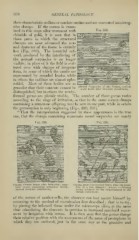Page 688 - My FlipBook
P. 688
B
698 GENERAL PATHOLOGY.
their characteristic stellate or caudate outline and are converted into irreg-
ular clumps. If the cornea is exam-
ined in this stage after treatment with Fig. 389.
chloride of gold, it is seen that in ^W.
those parts in which the structural p "^
changes are most advanced the nor- B
mal character of the tissue is entirely Br
lost (Fig. 389). The beautiful net-
work produced by the interlacing of Wf:
the normal corpuscles is no longer k
^
visible ; in place of it the field is scat-
^
tered over with clumps of irregular
form, in some of which the caudse are F
represented by rounded knobs, while m
in others the outlines are almost sphe- |r
roidal. Most of these bodies are so t^
Altered Corpuscles of the Cornea, excised
gidiuuar inai ineu^ COnrenih Cannoi Oe
crrnnnlir tlint tlipir r-nntpnts! r-nnnnf Iip
gj^jj^t jjo^j.^ after irritation (Sanderson).
distinguished, but in others the newly-
formed germs are plainly visible. The number of these germs varies
according to the stage of irritation, so that in the same cornea clumps
containing a numerous offspring may be seen in one part, while in others
the germination is only beginning (Figs. 390, 391).
" That the interpretation suggested by these appearances is the true
one, that the clumps containing numerous round corpuscles are nearly
Fig. 390. Fig. 391.
Cornea, sixteen hours after irritation: anioe- Cornea, ahout twenty-four hours after the iiiser-
lioid luasses containing numerous newly- tion of a fine ligature: masses containing
formed elements (Sanderson). young elements in the neighborhood of the
thread (.Sanderson).
of the nature of mother-cells, the observer can best assure himself by
returning to the method of examination first described ; that is to say,
by placing the inflamed tissue under the microscope alive, at the same
time stimulating the elements in question to increased amoeboid move-
ment by irrigation with serum. It is tiien seen that the germs chano-e
their relative ])osition Avith tlie movements of the mass of protoplasm in
whicii they are enclosed, just in tlie same way as the granules and
698 GENERAL PATHOLOGY.
their characteristic stellate or caudate outline and are converted into irreg-
ular clumps. If the cornea is exam-
ined in this stage after treatment with Fig. 389.
chloride of gold, it is seen that in ^W.
those parts in which the structural p "^
changes are most advanced the nor- B
mal character of the tissue is entirely Br
lost (Fig. 389). The beautiful net-
work produced by the interlacing of Wf:
the normal corpuscles is no longer k
^
visible ; in place of it the field is scat-
^
tered over with clumps of irregular
form, in some of which the caudse are F
represented by rounded knobs, while m
in others the outlines are almost sphe- |r
roidal. Most of these bodies are so t^
Altered Corpuscles of the Cornea, excised
gidiuuar inai ineu^ COnrenih Cannoi Oe
crrnnnlir tlint tlipir r-nntpnts! r-nnnnf Iip
gj^jj^t jjo^j.^ after irritation (Sanderson).
distinguished, but in others the newly-
formed germs are plainly visible. The number of these germs varies
according to the stage of irritation, so that in the same cornea clumps
containing a numerous offspring may be seen in one part, while in others
the germination is only beginning (Figs. 390, 391).
" That the interpretation suggested by these appearances is the true
one, that the clumps containing numerous round corpuscles are nearly
Fig. 390. Fig. 391.
Cornea, sixteen hours after irritation: anioe- Cornea, ahout twenty-four hours after the iiiser-
lioid luasses containing numerous newly- tion of a fine ligature: masses containing
formed elements (Sanderson). young elements in the neighborhood of the
thread (.Sanderson).
of the nature of mother-cells, the observer can best assure himself by
returning to the method of examination first described ; that is to say,
by placing the inflamed tissue under the microscope alive, at the same
time stimulating the elements in question to increased amoeboid move-
ment by irrigation with serum. It is tiien seen that the germs chano-e
their relative ])osition Avith tlie movements of the mass of protoplasm in
whicii they are enclosed, just in tlie same way as the granules and


